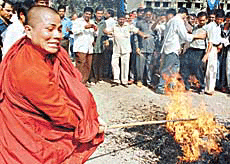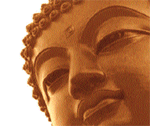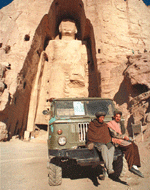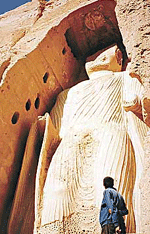| |
During his campaign of destruction and loot, at the turn of the second
millennium, Mahmud Ghazni wrought much destruction and desecration of
idols and icons. He vandalised many famous Hindu temples in North India,
including the famous Somnath temple in 1025 AD. But he did not desecrate
the Bamiyan Buddha which was about seven centuries old by then and
towered over the Bamiyan valley which was not very far from Ghazni.
Afghanistan was part of
Greater India from the dawn of history. After the Greek conqueror
Alexander’s invasion of India in 326 BC and retreat, his deputy
Seleucus was defeated and the Mauryan Empire arose which stretched as
far as the Hindukush region. Ashoka in the third century BC and Kanishka
in the first century BC, continued to hold sway in the region. It was
towards the end of the first century BC that Buddhism split into two
schools, Mahayana and Hinayana, and Buddha who was an agnostic and
against deification was turned into a deity. The Greek and Indian
traditions yielded the Gandhara School Of Art, resulting in beautiful
statues of Buddha and Boddhisatvas all over the Buddhist world,
extending from the Hindukush to Indo-China. The Bamiyan Buddha was a
part of this heritage. Gandhari in the epic Mahabharata is
believed to have come from this region.
 Afghanistan was part of
the Mughal empire till its decline after Aurangzeb. During the
empire-building days of the British, Afghanistan became the cockpit of
rivalry between the Russian empire and the British. The British in India
believed that their strategic interests extended up to the Hindukush in
order to ward off Russian intrusion. This led to the kings of
Afghanistan becoming loyal satraps of the British. Afghanistan was part of
the Mughal empire till its decline after Aurangzeb. During the
empire-building days of the British, Afghanistan became the cockpit of
rivalry between the Russian empire and the British. The British in India
believed that their strategic interests extended up to the Hindukush in
order to ward off Russian intrusion. This led to the kings of
Afghanistan becoming loyal satraps of the British.
After Independence and
the Partition, resulting in the emergence of Pakistan, India continued
to maintain an excellent rapport with the rulers of Afghanistan. The
most shining example of this was the visit of Prime Minister Indira
Gandhi in June 1969. On her arrival at Kabul, she was received by King
Zahir Shah. A cultural troupe consisting of Begum Akhtar, Kathak dancer
Damyanti Joshi and some others had accompanied the PM. Begum Akhtar’s
music performance in the Chalistoon Palace (Palace of Forty Pillars),
where Indira Gandhi was staying, enraptured the select audience,
including the members of the royal family. Indira Gandhi also laid the
foundation stone for a hospital at Kabul which was later run by a team
of Indian doctors. During her stay in Afghanistan, Indira Gandhi visited
the Panchsheer Valley across the Salang Pass on the highway leading to
Tashkent in Uzbekistan, which was then part of Russia. Indira Gandhi
also flew to Bamiyan and beheld the great Buddhist sculpture there.
Those were the balmy days and Kabul’s crowded bazaars were overflowing
with dry fruits and imported items. Indian merchants who were living
there for generations were doing roaring business. All this changed
later with coups and counter coups and the fleeing of King Zahir Shah
whose rule had been a stabilising influence for many years.
The Russian invasion in
1979, started all the terrible problems which are afflicting Afghanistan
even today. The Americans were determined to do a Vietnam on the
Russians and Pakistan became the staging post and a trusted ally for
pumping in arms and funds for the Afghan freedom fighters.
Fundamentalism crept in with the backing of Saudi Arabia, and after he
came to power in Pakistan, General Zia promoted fundamentalism
systematically. It was Zia again, who sowed the seeds of a large-scale
armed insurgency in the Kashmir valley. The Taliban, presently ruling
most parts of Afghanistan is the creation of Pakistan, USA and Saudi
Arabia. All these three countries should take responsibility for all the
excesses which have characterised the present Taliban rule. The rise of
Osama bin Laden is also one such outcome and he remains a bugbear and
one of the most hunted by Americans.
 After Mulla Omar gave
his orders for the destruction of Buddhist idols throughout Afghanistan,
Prime Minister Vajpayee wrote to several nations including the five
permanent members of the UN Security Council. Unfortunately and
strangely enough there was hardly any response from any of the world
leaders to his letter. Foreign Minister Jaswant Singh’s statement in
the Parliament that India would be happy to take the several Buddhist
statues from Afghanistan and bring them to India also failed to elicit
any response. On the other hand, a similar offer by Iran was given a
reply by Omar saying that Islam believed in destroying statues and not
in selling them. It is distressing to see that neither President George
Bush nor Tony Blair, nor for that matter Putin, condemned it, much less
respond to Vajpayee’s appeal. The ASEAN nations, consisting of several
Buddhist countries, did not issue a joint appeal either. After Mulla Omar gave
his orders for the destruction of Buddhist idols throughout Afghanistan,
Prime Minister Vajpayee wrote to several nations including the five
permanent members of the UN Security Council. Unfortunately and
strangely enough there was hardly any response from any of the world
leaders to his letter. Foreign Minister Jaswant Singh’s statement in
the Parliament that India would be happy to take the several Buddhist
statues from Afghanistan and bring them to India also failed to elicit
any response. On the other hand, a similar offer by Iran was given a
reply by Omar saying that Islam believed in destroying statues and not
in selling them. It is distressing to see that neither President George
Bush nor Tony Blair, nor for that matter Putin, condemned it, much less
respond to Vajpayee’s appeal. The ASEAN nations, consisting of several
Buddhist countries, did not issue a joint appeal either.
The reaction among the
Sangh Parivar leaders was, however, on expected lines. Prof Samuel P.
Huntington, the author of a much debated thesis, The Clash of
Civilisations? speaks of "the end of the Nehru legacy and the Hinduisation
of India" as one of the contributing factors for the growth of
fundamentalism in India. As a leading English daily commented,
"Where were these righteous guardians of Indian heritage when the
Babri Masjid was destroyed? If the statues in Bamiyan are our heritage,
so is the Babri Masjid". Is it possible that the muted reaction of
the world leaders to the Prime Minister’s appeal was because of the
Hindu fundamentalist tag which the NDA’s main constituent BJP has come
to acquire?
It is difficult to
resist the apprehension that the Taliban madness over the Bamiyan
statues is going to have its impact in Kashmir sooner or later. A
sizeable number of Afghan Taliban constitute the Lashkar-e-Toiba,
Jaish-e-Mohaamed and the Hizbul Mujahideen who are the dominant players
in the almost daily attacks in Kashmir. The extended ceasefire has made
no difference to them. They have warned the policemen in Jammu and
Kashmir to quit their jobs if they want to be alive. This threat has
been followed by a series of attacks on policemen, resulting in a large
number of casualties. The attacks on armed forces are becoming more and
more brazen and the ambush on the armed convoy in the outskirts of
Anantnag is very foreboding as it occurred in the town limits which
means it could not have occurred without the connivance of the people
around.
Mulla Mohhammad Omar
appealed to the world Muslims on March 5, "not to harmonise their
voices with those of non-believers as the infidels want to rob Islam of
its spirit". The implications of this statement are far reaching.
With the Pundits mostly driven out of Kashmir Valley, the Sikhs
are now being targeted. The Hurriyat leader Geelani claims that the
problem of Kashmir is one of religion and not of politics. Even though
the other Hurriyat leaders may not agree with him, Geelani is believed
to be more influential and pro-Pakistan. Taking into account all these
factors, what is the future of Kashmiriyat? The claim that the
people of the Valley believe in Kashmiriyat, having been fed on
Kashmir’s own Sufi saints and moderate Islamists over the centuries is
somewhat tenuous. Fundamentalism is sweeping Pakistan and its influence
has also spread to the Pakistan army. In this dangerous emerging
scenario what is the future of important Hindu landmarks in the Kashmir
Valley? Would Mulla Omar’s anti-infidel and anti-idolatry campaign
result in the militants targeting well-known and highly respected
landmarks like the Shankaracharya Hill, the Khir Bhawani Temple, the
Amarnath Cave etc? Nothing is sacred to them and they do not believe in
heritage and the word Kashmiriyat is anathema to them.
What are the lessons
which India should draw from the Bamiyan outrage? Does India have the
moral and physical courage and strength to stay on in Kashmir and not to
get demoralised by the constant deadly attacks against the armed forces,
the police and the civilians?
|
Taliban
flouts its own commitment...
By A. Balu
THE
Taliban regime may have compounded its heinous offence by reneging
on its own commitment to preserve all cultural heritage in the
country.
According to the
International Council on Monuments and Sites and the International
Council of Museums, the Taliban commitment was made in 1999.
Adding to the "dishonour" of breaking a commitment to
preserve the ancient and diverse heritage of Afghanistan as part
of the whole mankind, "such an act of destruction would be a
total cultural catastrophe. It would remain written in the pages
of history, next to the most infamous acts of barbarity."
 Non-government
organisations around the world have joined in condemning the
action of the Taliban leadership as an assault on the cultural and
historic achievements of humanity. Non-government
organisations around the world have joined in condemning the
action of the Taliban leadership as an assault on the cultural and
historic achievements of humanity.
The Society for
the Preservation of Afghanistan’s cultural heritage has
described the demolition of the Buddha statues as "absolutely
sickening."
Says Nancy Dupree
of the Society: "You cannot enter the Bamiyan valley without
being in awe of the creative dynamism of these figures. They
belong to the world. These old buildings are Afghanistan’s
identity, and when you lose your identity you have lost your
soul."
The Taliban
leader, Mullah Mohammad Omar, described in the media as a
"self-styled emir of all he surveys," is quoted as
saying "these idols have been gods of the infidels, who
worship them. The real god is only Allah — all other false gods
should be removed. Only the Allah the Almighty deserves to be
worshipped, not anyone else, or anything else."
"They are
trying to destroy Afghanistan’s memory," says Hamid Karzar,
a former deputy foreign minister of the ousted government of
Rabbani. Exiled Afghan writer Latif Pedram laments that Taliban is
destroying the roots of the country.
In contrast to
Iran’s strong reaction to the destruction of the Buddha statues,
Pakistan has confined itself to appealing to the Taliban regime to
give serious consideration to the international appeal without
disapproving the act of vandalism.
The most telling
comment has come from the UN special envoy to Afghanistan,
Francesc Vendrell: "It is as if the Indian government has
decided to destroy the Taj Mahal." Vendrell, who has in
recent weeks tried to persuade the Taliban regime to accept the UN
Secretary-General, Kofi Annan, as a mediator to the Afghan
conflict, has warned that the latest Taliban action is going to
have negative implications for Taliban’s image around the world.
Even more
pessimistic assessment was revealed in the comment of UN emergency
relief coordinator K. Oshima to reporters in Islamabad; "A
real tragedy is unfolding in front of us." The continuing
conflict in Afghanistan had led to a "massive human
suffering", he had said after a three-day visit to that
country last month.
Oshima has recommended
"exceptional actions" from the international community,
neighbouring states and the parties to the conflict, but the
latest defiant act of the Taliban could further isolate
Afghanistan from the rest of the world, with little prospect of a
bleeding Afghanistan seeing light at the end of the tunnel. |
|
Iconoclasm:
An article of faith?
By K.N. Pandita
THE
Indian Parliament has decried the demolition process of the world
famous statues in Afghanistan. India is a secular state and
Parliament has broken the secular tradition by passing a
resolution condemning an act of the upholders of a particular
faith. Has Parliament of a secular state a right to condemn an act
that is enjoined upon the faithful as their religious duty? In
demolishing the statue, the puritanical Taliban have, as ardent
upholders of a faith they profess, performed a duty that is among
the essential religious fundamentals or obligations viz.
demolition of idols, idol houses and destruction of idolatry. As
long as such symbols remain, the land is daru’l-barb,
meaning the land of conflict. Once the symbols and relics of a
pre-Islamic or non-Islamic faith are destroyed, it is the land of
peace or daru’l-amn or daru’l -salam.
Establishing the land of peace is the cherished goal of every
faithful Muslim wherever he is. As such, India, or for that matter
any other country, has no right to question why the strict
adherents of a particular faith carry out the commandments of
their religion.
 But is it the
first time that the faithful have embarked on a mission of
establishing the daru’l-amn? Indian Parliament should
have thought over the question. When the Arab commander conquered
Northern Egypt in about 654 AD, he came across a fabulously rich
library in Alexandria comprising mostly the manuscripts of the
writings of great Greek philosophers and intellectuals. Sa’d,
the commander, sent a message to Caliph Omar seeking instructions
on what to do with that treasure. Omar is reported to have said,
"Qur’an is the holy book sent down by God for us. It
contains all the knowledge on the earth and in the heaven. If the
books in the library in Alexandria contain anything more than what
our holy book contains, that is trash. And if those contain less,
we need them not at all." For six months, the library’s
books heated the baths (hammams) of Egypt, writes late Dr
Zabihullah Safa in The History of Rational Sciences in Islamic
Civilization. But is it the
first time that the faithful have embarked on a mission of
establishing the daru’l-amn? Indian Parliament should
have thought over the question. When the Arab commander conquered
Northern Egypt in about 654 AD, he came across a fabulously rich
library in Alexandria comprising mostly the manuscripts of the
writings of great Greek philosophers and intellectuals. Sa’d,
the commander, sent a message to Caliph Omar seeking instructions
on what to do with that treasure. Omar is reported to have said,
"Qur’an is the holy book sent down by God for us. It
contains all the knowledge on the earth and in the heaven. If the
books in the library in Alexandria contain anything more than what
our holy book contains, that is trash. And if those contain less,
we need them not at all." For six months, the library’s
books heated the baths (hammams) of Egypt, writes late Dr
Zabihullah Safa in The History of Rational Sciences in Islamic
Civilization.
After their victories in the
battles of Qadisiyyeh and Nehavand in 652 AD resulting in the
liquidation of the Sasanian empire, the first thing the Arab
conquerors undertook to do was the wholesale destruction of the
free-temples (atashkadesh) of the Zoroastrians faith, the
faith of the Iranians of those days. Tarikh-I-Yamini, the
history of Mahmud of Ghazna, and many other Persian chronicles
have recorded the story of Mahmud’s iconoclasm, including the
destruction of the Somnath temple. Farrukhi, the panegyrist of the
House of Mahmud, has a powerful qasida eulogizing his
patron — the Amiru’l-Momineen — for his iconoclastic
achievements in India. A secular state like India may need to
amend the constitutional provision that allows Parliament to
question the performance of a religious duty by the followers of
that religion. It must not politicise principles. It did not pass
any condemnation resolution when the faithful extirpated three
hundred thousand Kashmirs not belonging to the Muslim faith from
their homeland at gunpoint in 1990. But it did react when the
faithful are axing down the Buddhas at Bamiyan. The question is
when the Indian Parliament was not perturbed by the extirpation of
living human mass of its own citizens in Kashmir, why does it
become nervous if a few hundred tons of granite are crushed at
Bamiyan by the Muslim puritans in observance of their religious
commandment with weaponry invented by the western kafirs?
Isn’t it a crude way of playing the communal card? |
|
